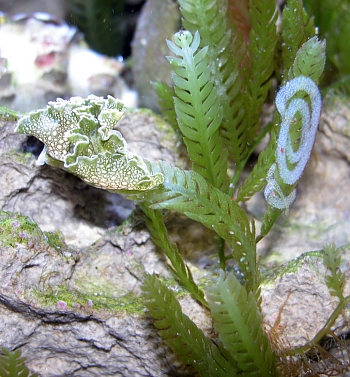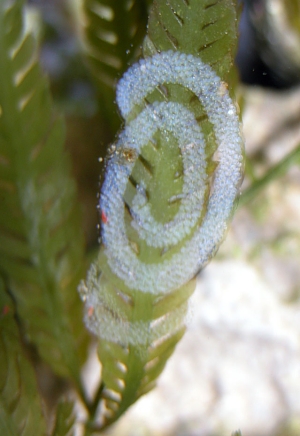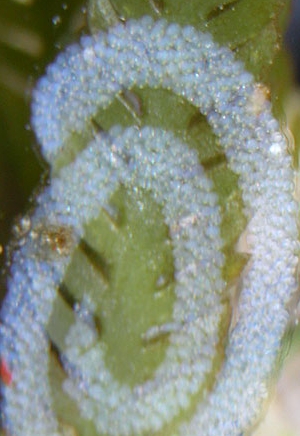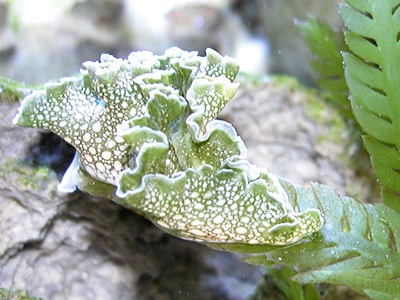Elysia clarki breeding in the home aquarium
May 30, 2006
From: Matt Pedersen

I'm seeking thoughts and advice on the breeding and rearing of Elysia crispata in the home aquarium. Not too long ago I added my first specimen, and after reading up a bit more was struck by the idea of attempting to intentionally propagate the species, if possible, rather than just getting "lucky" as many folks have in the past.
As my "luck" would have it, I obtained a second E. crispata earlier today. Within 6 hours of introduction to the aquarium, it appears that the 2nd specimen has laid an egg ribbon on one of the several Caulerpa sp. growing in the aquarium.
Initially I had observed this smaller specimen coiled around the Caulerpa and assumed it was feeding...observing a few hours later I found the string of eggs where the nudi had been "feeding". While I can't say with 100% certainty that these eggs were indeed produced by the nudi (as I did not actually witness the laying of the eggs), there isn't much else in the aquarium that could have produced the egg ribbon in the elapsed time span! So much for "intentional" vs. "random" breeding!
The question is now, what next? I suspect while there's little in the aquarium that would feed on the eggs, allowing the larvae to develop in the tank could be less than productive. I've looked into rearing schemes for other Nudibranchs, particularly an AZAA Article Online detailing the culture of Berghia sp. (http://www.breedersregistry.org/Reprints/azaa/1996/berghia_azaa.htm ).
My initial thoughts have been to cut a portion of the Caulerpa (and egg mass) away and separate them to a non-filtered container for hatching an initial rearing. The remaining portion of the eggs would be allowed to develop without further "help", still attatched at it's original site of deposit, in the main aquarium. Will splitting the egg mass cause damage/decay/demise of the entire egg mass?
If the splitting would be successful, I believe I can find some macroalgae that would sustain the separated larvae, hopefully getting them to a size where they could then be distributed.
As if this weren't enough, along with the 2nd E. crispata I introduced today, I came across a pair of "different" Lettuce Nudibranchs. After examination of the species photographs contained on this website, I am convinced that these 2 new specimens are Elysia diomedea. My concerns regarding the "polyculture" of these two species side-by-side are raised in a forthcoming message.
I've included some pics of the E. crispata and the eggs - my apologies if they are a bit large but I felt the detail might be helpful.
Best Regards,
Matt Pedersen
matt@cichlidrecipe.com



Dear Matt,
Sorry I didn't reply immediately to your message but I was expecting some changes to the 'Lettuce Slug' story any day. As you will see by my message today [#16727], your slug is the recently named species Elysia clarki.
Concerning looking after the larvae you are in luck because this species has swimming larvae which don't feed, and only spend 4 or 5 days in the water before turning into small crawling slugs. You'll see a couple of species listed on the Fact Sheet as juvenile food, but it is more than possible that they feed on other green algae as well. Certainly as you will have seen in earlier messages, other people have had success in their aquaria with just the algae common green algae growing in their tanks. I suspect all the aquarium success stories on the Forum refer to E. clarki rather than E, crispata. Because they keep chloroplasts alive in their tissues [see solar powered slugs] you will need aquarium lights that assist plant growth. Let us know if you have any success
Best wishes,
Bill Rudman
Related messages
-
Relationship of Elysia diomedea and E. crispata
From: Patrick Krug, October 6, 2008 -
Elysia clarki feeding practices
From: Adam D'Agosto, December 6, 2007 -
Elysia clarki and E. crispata in Florida
From: Skip Pierce, October 10, 2007 -
Re: Elysia crispata in Cozumel, Mexico
From: Skip Pierce, February 2, 2007 -
Re: Elysia crispata in Cozumel, Mexico
From: Jim Lyle, February 2, 2007 -
Re: Elysia crispata in Cozumel, Mexico
From: Sean Kearney, February 2, 2007 -
Re: Elysia crispata in Cozumel, Mexico
From: Skip Pierce, February 1, 2007 -
Elysia crispata in Cozumel, Mexico
From: Sean Kearney, January 29, 2007 -
Elysia clarki feeding references
From: Nicholas Curtis, January 29, 2007 -
Re: What's wrong with Elysia clarki?
From: Colin Redfern, September 9, 2006 -
Re: What's wrong with Elysia clarki?
From: Colin Redfern, September 9, 2006 -
Re: What's wrong with Elysia clarki?
From: Skip Pierce, September 8, 2006 -
Re: What's wrong with Elysia clarki?
From: Angel Valdes, September 7, 2006 -
Re: What's wrong with Elysia clarki?
From: Skip Pierce, September 1, 2006 -
Re: Damaged Elysia crispata
From: Nick Curtis, August 31, 2006 -
What's wrong with Elysia clarki?
From: Bill Rudman, August 30, 2006 -
Elysia diomedea & E. clarki in home aquarium?
From: Matt Pedersen, May 30, 2006 -
Elysia clarki, E. diomedea and E. crispata
From: Bill Rudman, May 30, 2006 -
A new Elysia from Florida
From: Bill Rudman, May 30, 2006 -
Lettuce Sea Slug behavior and feeding
From: Patrick Glenn, April 13, 2006 -
What to feed Elysia crispata?
From: Alexandra Ahnide, April 11, 2006 -
Elysia crispata feeding and babies
From: Willem Bermel, January 31, 2006 -
Re: Colour in Elysia (again)
From: Anne DuPont, November 7, 2005 -
Re: Lettuce sea slug - breeding success
From: Vincent, June 27, 2003 -
Lettuce sea slug - breeding success
From: Rick Hahn, May 31, 2003 -
Re: Gene transfer - Elysia crispata
From: Skip Pierce, May 5, 2003 -
Re: Algal genes in Elysia crispata
From: Philip Cromwell, May 3, 2003 -
Re: Elysia crispata and algal genes
From: Skip Pierce, May 3, 2003 -
Algal genes in Elysia crispata
From: Skip Pierce, May 2, 2003 -
Elysia crispata babies
From: Joe Bongiorno, December 30, 2002 -
Re: Baby slugs!
From: Joe Bongiorno, December 18, 2002 -
Re: Baby slugs!
From: Joe Bongiorno, December 10, 2002 -
Bifid rhinophores in Elysia crispata
From: Anna L. Bass, September 12, 2002 -
Elysia crispata? in aquaria
From: Ash, April 1, 2002 -
Re: Baby slugs! - Elysia crispata
From: Jeff Zimmerman, June 4, 2001 -
Re: Baby slugs! - Elysia crispata
From: Jeff Zimmerman, March 22, 2001 -
Baby slugs!
From: Jeff Zimmerman, March 17, 2001
